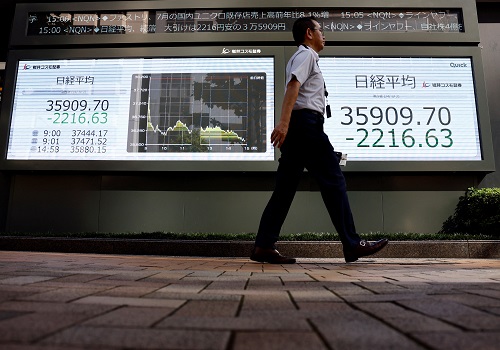
Asian share markets slid on Monday after worries about a possible U.S. economic downturn slugged Wall Street, though U.S. stock futures did rally from an early dip and bond yields came off their lows.
Data on consumer prices (CPI) from China showed the Asian giant remained a driver of global disinflation, with producer prices falling an annual 1.8% in August when analysts had looked for a drop of 1.4%.
The CPI also missed forecasts at 0.6% for the year, with almost all the rise in food prices and goods prices up just 0.2%, pointing to subdued domestic demand.
Japan's Nikkei bore the brunt of the selling as tech stocks declined, losing another 2.4% on top of a near 6% slide last week. [.T]
MSCI's broadest index of Asia-Pacific shares outside Japan slipped 1.2%, after shedding 2.25% last week, while South Korea's market fell 1.3%.
On a brighter note, S&P 500 futures and Nasdaq futures both edged up 0.2% following Friday's slide. EUROSTOXX 50 futures added 0.3% and FTSE futures firmed 0.5%.
Fed fund futures dipped as investors wondered whether the mixed U.S. August payrolls report would be enough to tip the Federal Reserve into cutting rates by an outsized 50 basis points when it meets next week.
So far, markets imply a 33% chance of a large cut, in part due to comments from Fed Governor Christopher Waller and New York Fed President John Williams on Friday, though Waller did leave open the option of aggressive easing.
"Our read of the data is that the labour market continues to cool, but we see no sign of the kind of rapid deterioration in conditions that would call for a 50bp rate cut," Barclays economist Christian Keller said.
"Importantly, we also see no indication of any appetite for this in Fed communications," he added. "We retain our call for the Fed to begin its cycle with a 25bp cut, followed by two more 25bp at the remaining two meetings this year, and a total of 75bp of cuts next year."
Investors are considerably more dovish and have priced in 113 basis points of easing by Christmas and another 132 basis points for 2025.
Data on August U.S. consumer prices on Wednesday should underline the case for a cut, if not the size, with headline inflation seen slowing to 2.6% from 2.9%.
Tuesday sees Democrat Kamala Harris and Republican Donald Trump debate for the first time ahead of the presidential election on Nov. 5.
ECB TO EASE
Markets are also fully priced for a quarter-point cut from the European Central Bank on Thursday, but are less sure on whether it will ease in both October and December.
"What matters will be guidance beyond September, where there's strong pressure on both sides," analysts at TD Securities noted in a note.
"Wage growth and services inflation remain strong, emboldening the hawks, while growth indicators are flagging softer, emboldening the doves," they added. "Quarterly cuts are likely more consistent with the new projections."
The prospect of global policy easing boosted bonds, with 10-year Treasury yields hitting 15-month lows and two-year yields the lowest since March 2023.
Bonds ran into some profit taking on Monday as two-year yields nudged up to 3.690% and the 10-year to 3.743%, though the curve was still near its steepest since mid-2022.
The yen also gave up some of its gains as the dollar firmed 0.4% to 142.7 yen and away from Friday's trough of 141.75. The euro held at $1.1086, having briefly been as high as $1.1155 on Friday. [USD/]
In commodity markets, the downward trend in bond yields kept gold restrained at $2,497 an ounce and short of its recent all-time top of $2.531. [GOL/]
Oil prices found some support after suffering their biggest weekly fall in 11 months last week amid persistent concerns about global demand. [O/R]
Brent bounced $1.01 to reach $72.07 a barrel, while U.S. crude firmed $1.02 to $68.69 per barrel.
